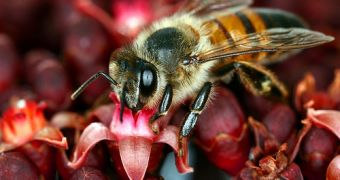A team of researchers led by research professor Jerry Bromenshenk from the University of Montana in Missoula, and including virologists and chemists from the U.S. Army Edgewood Chemical Biological Center and the Instituto de Ecologica AC in Mexico, has been working on the causes of the bee colonies collapse, ever since the late 2006, across all the North America.
Shan Bilimoria, a professor and molecular virologist at Texas Tech University and a member of the research team, said that the latest research has started to shed some light on this mysterious disorder, and one of the causes of the bees disappearing is that they are being attacked by viruses as well as by fungus.
Before getting to this conclusion, the researchers crashed dead bees and after using spectroscopic analysis, they found evidence of a moth virus called IIV6 – insect iridescent virus, and of a fungal parasite called Nosema.
Bilimoria said that the insect virus is very close to one that had decimated bee populations in India, 20 years ago, but unlike other viruses that contained RNA, this one contains DNA.
“Our DNA discovery puts this field in a whole new direction,” Bilimoria said.
Scientists don't know yet if the two pathogens cause Colony Collapse Disorder – CCD, or whether CCD colonies are more vulnerable to the two pathogens.
“At this stage, the study is showing an association of death rates of the bees with the virus and fungus present.
“Our contribution to this study confirms association, but even that doesn't prove cause and effect; not just yet,” said Bilimoria.
Anyway, the CCD is a rather serious phenomenon and it has a big impact on agriculture, as much of it depends on bees to pollinate crops.
To find the causes and the effects of CCDs, researchers will “have to isolate the virus and fungus from bee colony, and then reinfect with same virus and fungus.
“Once we isolate and identify the virus, we will have a way of monitoring it.
“It is easier to fight the problem if we know what the culprit is,” Bilimoria concluded.
The study was published this week in the peer-reviewed journal PLoS ONE.
Watch a video of Texas Tech researchers studying bee colony collapse:

 14 DAY TRIAL //
14 DAY TRIAL //